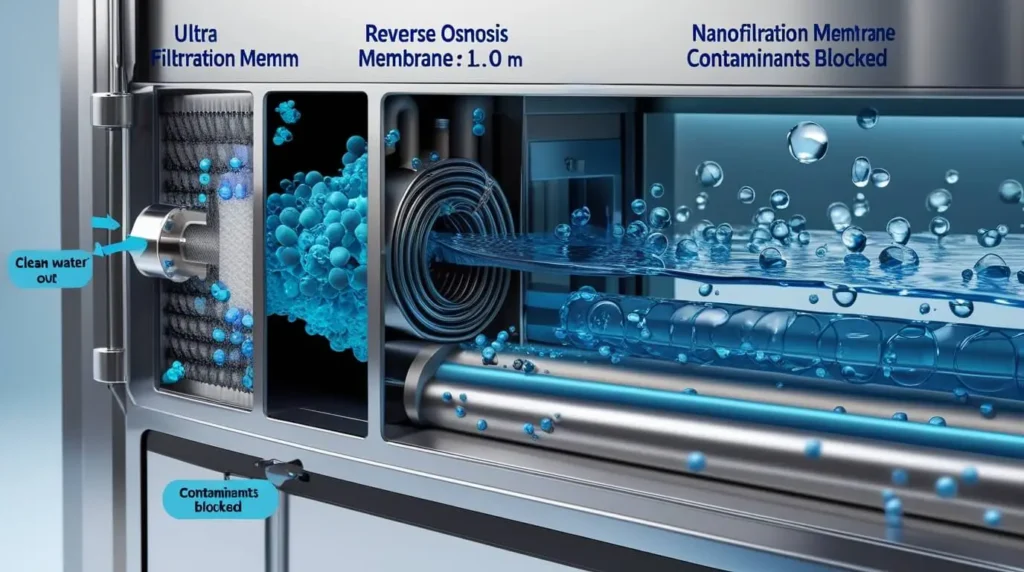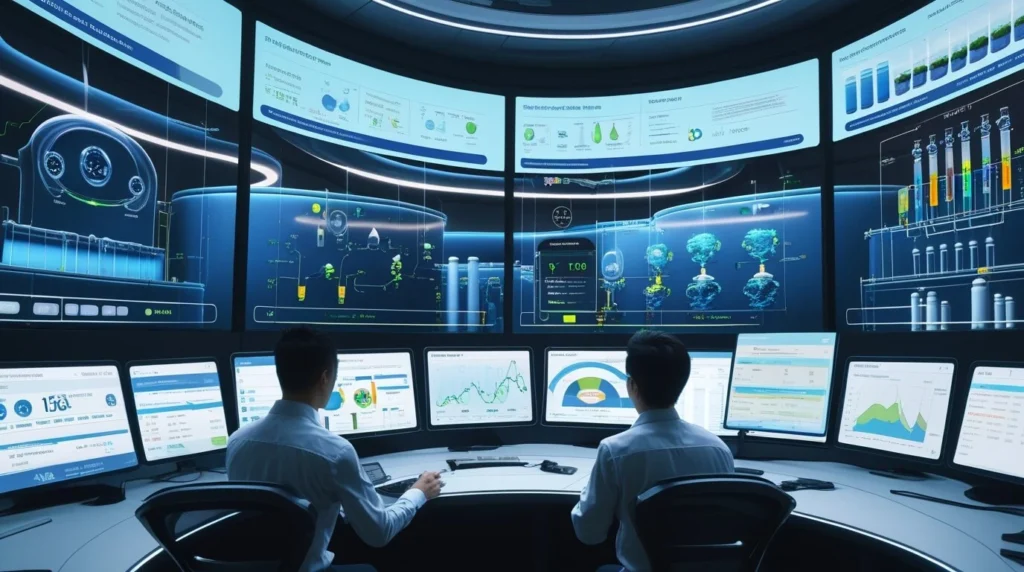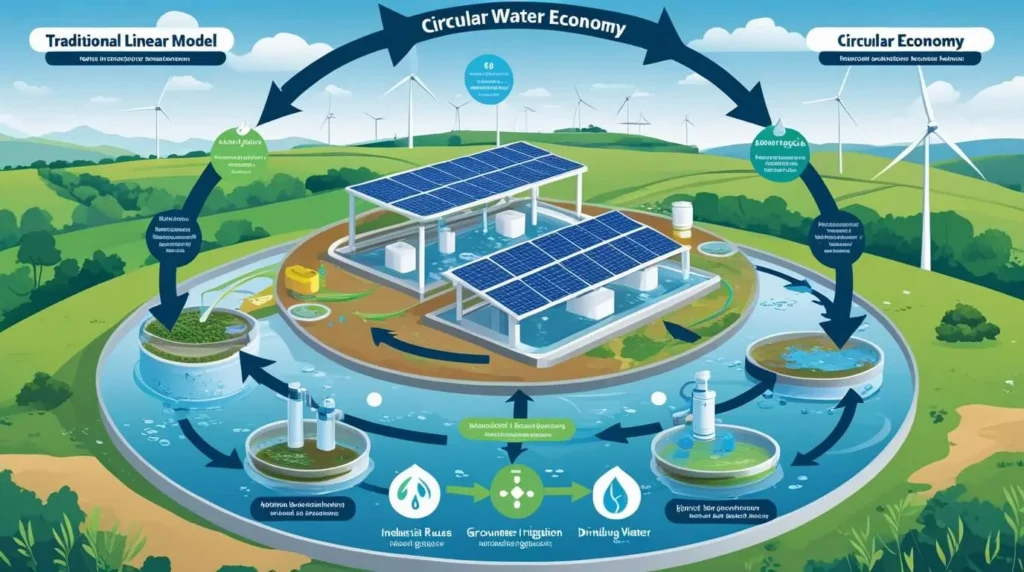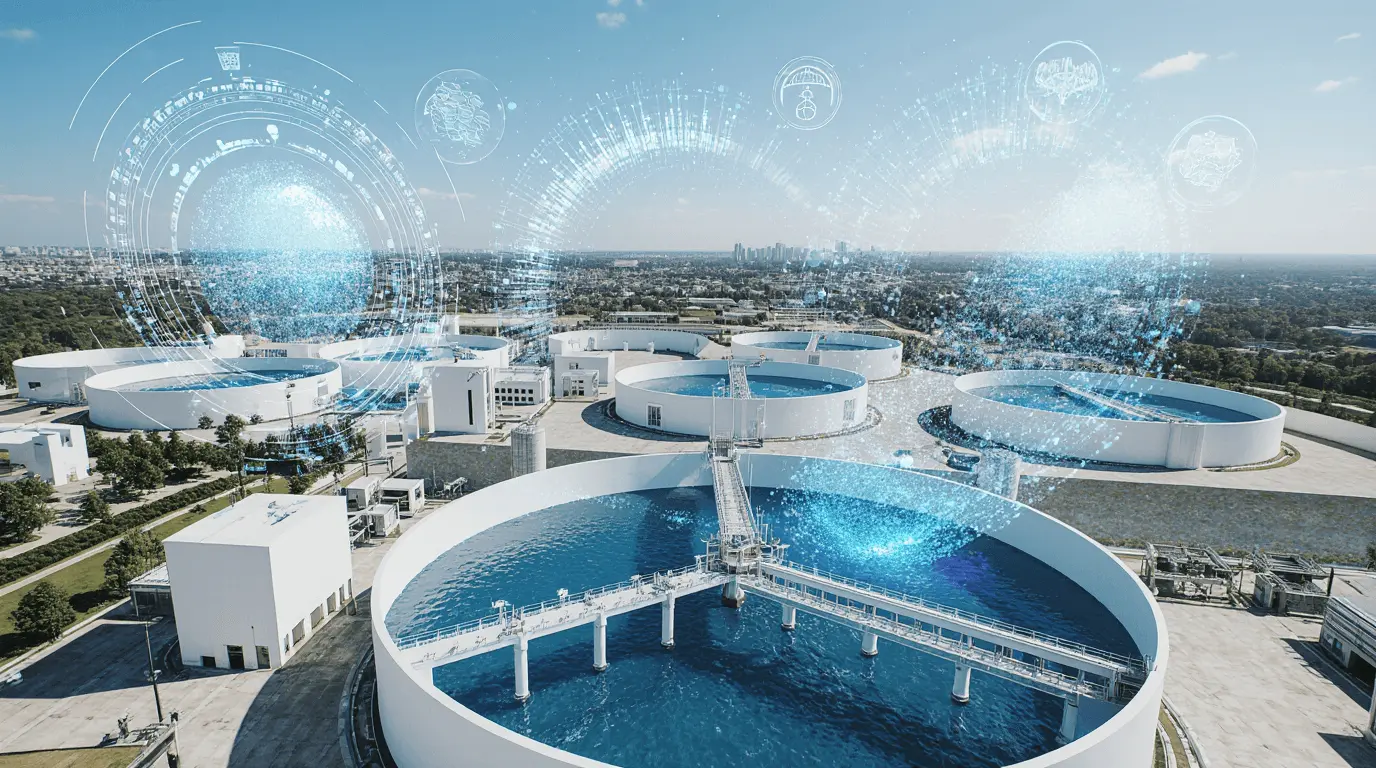⚡ Quick Answer: These 5 water treatment steps—coagulation, flocculation, sedimentation, filtration, and disinfection—eliminate 99.9% of harmful impurities. Today’s utilities worldwide also complement these traditional processes with AI monitoring, PFAS removal systems, and green purification systems. Jump to: The 5 Steps | Advanced Technologies | Global Examples
Table of Contents
How exactly does water treatment work?
Drinking water utilities worldwide treat billions of gallons of water every day to make it ready for human consumption. But what is the water treatment process?
The traditional water treatment process entails five fundamental steps that work together to remove impurities and render water potable. These steps form the foundation of modern water purification worldwide.
| Step | Purpose | Key Technology | Removal Target |
|---|---|---|---|
| 1. Coagulation | Bind particles | Aluminum/Iron salts | Dirt, bacteria, organics |
| 2. Flocculation | Form larger clumps | Gentle mixing | Suspended particles |
| 3. Sedimentation | Separate solids | Gravity settling | Heavy particles |
| 4. Filtration | Physical barrier | Sand, carbon, membranes | Microorganisms, chemicals |
| 5. Disinfection | Kill pathogens | Chlorine, UV, ozone | Bacteria, viruses |
Step 1: Coagulation – Binding the Invisible
The water treatment process begins when raw water arrives at the water treatment plant. During coagulation, operators add some chemicals—typically aluminum or iron salts—to the water.
How it works:
- Coagulants have a positive electrical charge
- They are drawn to negatively charged bacteria and dirt particles
- Tiny impurities stick together
- Provides foundation for development of larger particles
Global example: Shanghai’s Yangtze River Water Treatment Plant (7.2 million cubic meters per day) uses polyaluminum chloride (PAC), which outperforms traditional aluminum sulfate in treating heavily contaminated river water.
Step 2: Flocculation – Creating Larger Particles
After coagulation binds particles together, slow mixing during flocculation results in these little clumps sticking together to form bigger aggregates called “flocs.”
The process:
- Slow, gentle agitating brings particles together
- Forming larger, heavier clumps (flocs)
- Polymers increase flocs’ strength
- Prepares water to settle
Advanced technology: State-of-the-art technology: Beijing Waterworks Group uses high-rate clarifiers that reduce the time spent on flocculation by 50% with a higher quality of water.
Step 3: Sedimentation – Gravity Does the Work
When water carries larger, heavier floc particles, gravity settles solids from clear water in massive settling tanks.
Key features:
- Heavy flocs settle at bottom
- Process takes 2-4 hours
- Clear water floats on top
- Settled sludge is occasionally removed
Modern innovation: Inclined plate settlers and tube settlers increase settling surface, significantly speeding up the process.
Step 4: Filtration – The Critical Barrier
Pure water passes through filters that can catch remaining particles, like disease-causing parasites, bacteria, and viruses.
Traditional Filtration Layers:
| Layer | Material | Function |
|---|---|---|
| Top | Anthracite coal | Catches larger particles |
| Middle | Fine sand | Traps smaller contaminants |
| Lower | Coarse sand | Additional filtration |
| Bottom | Gravel | Supports upper layers |
| Special | Activated carbon | Removes chemicals, odors |
Advanced Filtration Technologies (2025)

Ultrafiltration (UF)
- Membrane pores: 0.01 to 0.1 microns
- Removes: 99.99% of bacteria and viruses
- Example: Taihu Lake Water Treatment Plant in Wuxi, China—one of the world’s first large-scale UF facilities (400,000 m³/day capacity)
Reverse Osmosis (RO)
- Removes dissolved salts and metals
- Used for desalination and water reuse
- Energy consumption reduced 20-30% with new membranes
Nanofiltration (NF)
- Between UF and RO in selectivity
- Lower energy use than RO
- Targets specific contaminants
Step 5: Disinfection – The Final Safety Step
The last critical phase kills any remaining microorganisms that survived filtration.
Common Disinfection Methods:
| Method | Advantages | Disadvantages | Global Usage |
|---|---|---|---|
| Chlorine | Cheap, residual protection | Taste, some byproducts | Most common worldwide |
| Chloramine | Longer-lasting, fewer byproducts | Slower acting | China, USA, UK |
| UV Light | No chemicals, no taste | No residual protection | Often combined with chlorine |
| Ozone | Powerful, breaks down organics | No residual, expensive | Europe, Japan preferred |
Why residual matters: A slight chlorine smell means the disinfectant is still working as water travels through pipes—sometimes many miles from the treatment plant to your tap.
What Additional Treatments Improve Water Quality?
Beyond the five core steps, utilities adjust water chemistry for enhanced safety and quality.
pH Adjustment Benefits:
- ✓ Improves taste
- ✓ Reduces pipe corrosion
- ✓ Prevents lead/copper leaching
- ✓ Enhances disinfection effectiveness
- ✓ Extends infrastructure lifespan
Fluoride Addition
Many countries add fluoride to strengthen tooth enamel and reduce cavities by 25% in both children and adults.
Global variation:
- Common: Australia, USA, parts of South America
- Selective: China (only in low-fluoride regions)
- Rare: Most European countries (use fluoridated salt instead)
How Are Advanced Technologies Revolutionizing Water Treatment in 2025?

Though traditional water treatment processes remain effective, emerging technologies are addressing new challenges and maximizing efficiency globally.
AI and IoT: The Smart Water Revolution
Artificial Intelligence and Internet of Things are transforming utility operations to monitor and maximize the water treatment process.
Real-Time Monitoring Metrics:
- Water quality (pH, turbidity, chlorine)
- Flow rates and pressure
- Equipment performance
- Energy consumption
- Chemical use
China’s leadership: Shenzhen Water Group implemented AI in 15 treatment plants, processing 1.2 million hourly data points.
Achieved results:
- 18% reduced chemical usage
- 23% reduced energy usage
- Improved output water quality
- Preventive maintenance preventing breakdowns
Singapore’s innovation: PUB developed digital twin models of their entire water network, allowing operators to model scenarios and optimize operations years in advance.
Next-Generation Membrane Technologies
| Technology | Innovation | Impact |
|---|---|---|
| Nanocomposite Membranes | Integrate nanomaterials | Resist fouling, last longer |
| Biomimetic Materials | Mimic biological structures | 30% less energy required |
| Low-Energy RO | Advanced membrane design | 20-30% cost reduction |
| Ultrafiltration Scale-Up | Large-scale deployment | Cost per cubic meter down 40% |
Manufacturing shift: Chinese companies like Originwater and Memstar now produce over 40% of the world’s water treatment membranes, driving down global costs.
Tackling “Forever Chemicals” (PFAS)
PFAS are synthetic chemicals found in non-stick cookware and firefighting foam. Their strong carbon-fluorine bonds resist breakdown in conventional water treatment.
Why PFAS Matters:
- Linked to cancer and liver damage
- Affects immune system development
- Found in water sources worldwide
- Doesn’t break down naturally
Specialized PFAS Removal Technologies:
1. Electrochemical Oxidation
- Uses electricity to generate oxidants
- Breaks down PFAS molecules
- Can be deployed on-site
- Example: Netherlands’ Waternet Amsterdam successfully treats contaminated groundwater
2. Ion Exchange Resins
- Specially designed to capture PFAS
- Works like molecular sponges
- Integrates with existing systems
- High effectiveness for specific PFAS compounds
3. Advanced Adsorption
- Specially treated activated carbon
- Higher capacity than traditional filters
- Selective for PFAS molecules
- Cost-effective for many applications
Advanced Oxidation Processes (AOPs)
AOPs use highly reactive species to degrade contaminants that resist conventional treatment.
What AOPs Remove:
- 💊 Pharmaceuticals and personal care products
- 🌾 Pesticides and herbicides
- ⚗️ Endocrine-disrupting chemicals
- 🏭 Industrial compounds
Common AOP Methods:
| Method | How It Works | Best For |
|---|---|---|
| UV/H₂O₂ | UV light + hydrogen peroxide = hydroxyl radicals | General organics |
| Ozonation | Ozone gas oxidizes contaminants | Taste, odor, microorganisms |
| Photocatalysis | Titanium dioxide + UV light | Persistent pollutants |
Japan’s success: Tokyo treatment plants use ozone-biological activated carbon systems, achieving 95%+ removal of pharmaceutical residues and endocrine disruptors.
Modular and Decentralized Systems
Flexible, smaller-scale systems deployed where needed rather than relying solely on large centralized plants.
Benefits:
- ⚡ Rapid deployment for emergencies
- 💰 Cost-effective for remote areas
- 🔄 Enables local water reuse
- 📈 Scales with population growth
Rural transformation: China’s rural water safety program deployed 50,000+ modular treatment systems since 2019, bringing clean water to 280 million rural residents.
Why Does Water Treatment Differ Between Communities?
The specific water treatment process depends on source water quality and regional challenges.
Surface Water vs. Groundwater
| Water Source | Treatment Needed | Why |
|---|---|---|
| Surface Water (lakes, rivers) | Extensive (all 5 steps) | High sediment, pollutants, microorganisms, seasonal variation |
| Groundwater (wells) | Minimal (often just disinfection) | Natural filtration, consistent quality, lower contamination |
The Yangtze River challenge: Supplies water to 400 million people but faces severe pollution. Treatment plants require multi-barrier approaches:
- Pre-oxidation
- Enhanced coagulation
- Ozone-biological activated carbon
- Membrane filtration
Special Contaminants Requiring Extra Treatment
| Contaminant | Source | Health Risk | Treatment Method |
|---|---|---|---|
| Nitrates | Agricultural runoff | Blue baby syndrome | Ion exchange, biological treatment |
| Arsenic | Natural in groundwater | Cancer, organ damage | Specialized filters, RO |
| Cyanotoxins | Algal blooms | Liver damage, neurological | Advanced oxidation, activated carbon |
| Radionuclides | Natural radioactive particles | Cancer risk | RO, ion exchange |
Taihu Lake response: After the 2007 algal bloom contaminated water for 2 million people in Wuxi, China invested $14 billion in watershed management and treatment upgrades.
How Is Water Treatment Becoming More Sustainable?
The future emphasizes sustainability, resource recovery, and circular economy principles.

Water Reuse Applications
| Use Type | Treatment Level | Examples |
|---|---|---|
| Industrial | Medium | Cooling systems, manufacturing |
| Agricultural | Medium-High | Crop irrigation |
| Groundwater Recharge | High | Aquifer replenishment |
| Direct Potable | Ultra-high | Drinking water supply |
Singapore’s NEWater: Multi-barrier process (microfiltration → reverse osmosis → UV disinfection) produces ultra-clean recycled water meeting 40% of the nation’s water demand.
Namibia’s pioneer: Windhoek has operated the world’s first direct potable reuse plant since 1968, now supplying 35% of the city’s drinking water.
Energy Efficiency Innovations
Renewable Energy Integration:
- ☀️ Solar panels on treatment facilities
- 💨 Wind turbines for power generation
- ♻️ Energy recovery from wastewater
- 🔥 Biogas from anaerobic digestion
China’s solar success: Qingdao West Coast wastewater treatment plant generates 40% of power needs from 61,000 m² of rooftop solar panels, reducing CO₂ emissions by 8,000 tons annually.
Denmark’s achievement: Avedøre plant near Copenhagen produces 150% of its energy needs through biogas and heat recovery, selling excess electricity to the grid.
Resource Recovery Opportunities
Modern utilities extract valuable materials from wastewater:
Nutrients (Phosphorus & Nitrogen)
- Extracted and sold as fertilizers
- Reduces mining dependence
- Netherlands: Recovers 90% of phosphorus from sewage sludge
Metals (Precious & Rare Earth)
- Gold, silver, platinum, copper
- Recovered from industrial streams
- Japan: Tokyo sewage yields more gold per ton than many gold mines
Energy (Biogas)
- Generated from organic waste
- Powers treatment plants
- Can fuel vehicles or feed power grid
What Does the Future Hold for Water Treatment?
Looking toward 2030 and beyond, several trends will reshape global water treatment:
Key Future Developments:
1. Hybrid Membrane Systems
- Combines multiple membrane types
- Superior contaminant removal
- 25-40% more energy efficient
2. AI-Optimized Networks
- Machine learning coordination
- Regional water security
- Waste minimization
3. Near-Zero Liquid Discharge
- Recovers virtually all water
- Only solid residuals disposed
- Essential for water-scarce regions
4. Climate Adaptation
- Handles variable water quality
- Responds to extreme weather
- Adjusts to changing contaminant profiles
South Korea’s vision: Developing integrated smart water management connecting all major cities by 2030, using real-time data sharing and AI prediction models.
Frequently Asked Questions
How do I know whether my tap water is safe to drink?
Drinking water quality is regularly tested and reported by water utilities. Ask your local provider for annual reports. In China, the Ministry of Ecology and Environment coordinates testing, and major cities post results on-line. For older pipes, ask for independent laboratory tests.
What types of contaminants does water treatment remove?
Treatment removes microorganisms (bacteria, viruses, parasites), physical contaminants (sediment, organic matter), and chemicals (metals, pesticides). Cutting-edge systems remove PFAS, medications, and nitrates.
Why does my tap water smell like chlorine?
Mild chlorine smell means water is disinfected. Strong odor? Contact your utility. To reduce it, refrigerate water, filter with carbon, or let it sit before drinking.
What is China’s new technology for water treatment?
China is a leader in ultrafiltration plants, AI-controlled technologies, modular rural units, and the 1,400 km South–North Diversion. Projects like Sponge Cities and resource recovery further support sustainability.
Conclusion: The Optimal Combination of Trusty Old and New
Water treatment has protected public health for centuries in five basic steps: coagulation, flocculation, sedimentation, filtration, and disinfection.
Now, challenges like PFAS pollution, climate change, and aging infrastructure demand innovation.
The future is in integrating:
🤖 AI monitoring
🧬 Advanced membranes
⚗️ Design contaminant removal
♻️ Resource recovery
From Singapore’s NEWater and China’s smart water infrastructures to the U.S. PFAS upgrade facilities and digital optimization—countries around the world are blending tradition with technology to supply safe, sustainable water for all.
Take Action Today
Start your plant-based water purification journey:
- Subscribe to our Newsletter – Get expert tips on sustainable water treatment, real-world case studies, and practical solutions to improve water quality in your home and community.

